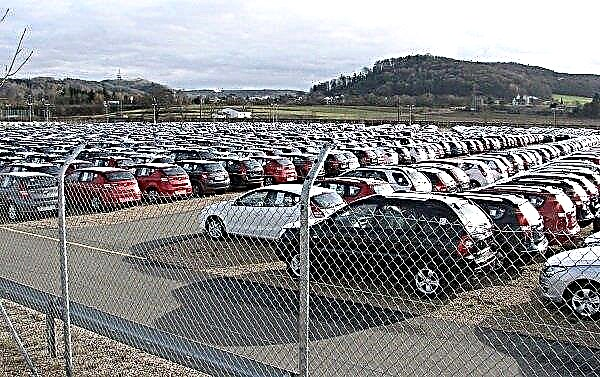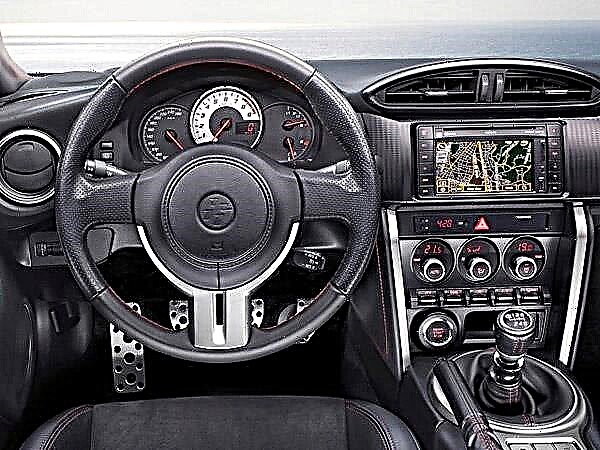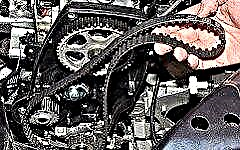
The gas distribution mechanism (abbreviated as the timing) is the most important unit in the vehicle, which is responsible for the supply and release of the working fluid in the power plant. The mechanism regulates the phases of the distribution of fuel in the cylinders with the subsequent removal of exhaust gases. In the event of a failure of this unit, the operation of the car becomes impossible.
The device and purpose of the timing belt

Before you get acquainted with the symptoms of timing belt malfunctions, you should clarify its structure and principle of operation. The main purpose of this system is the timely filling of the cylinders with a fuel-air mixture and the removal of fuel combustion products.
To solve the set tasks, the timing mechanism opens or closes the intake and exhaust valves on the engine cylinders in time. The valves are controlled by a camshaft, which is found on most modern power units.
In order for the camshaft to operate on time, it needs to receive the rotational potential from the crankshaft using a special drive system that includes pulleys and a gas distribution belt.
The timing belt is responsible for the synchronous operation of the two nodes. In progressive power plants that are installed on machines, the mechanism is able to control the pump of the cooling system.
In most cases, the belt is located at the front of the engine compartment, between the engine cylinders and the radiators. In some versions of the internal combustion engine, the unit can be found immediately after opening the hood, but by default it is hidden under a protective casing. Removing such an insert is quite simple.
In appearance, the timing belt is a closed toothed rim. At the same time, there are no universal components, because they are unique to all powerplant modifications. The first belts were made of rubber with a textile cord.
Modern products are made from high-strength fiberglass or polymer fibers. Such materials are characterized by increased resistance to wear and temperature shocks.
Visual check of the timing belt condition

To eliminate serious problems with the timing belt, it is necessary to diagnose the part in time. Experts recommend doing this at least once a month.
On visual inspection, minor damage to the material of manufacture can be determined, but this is not a sign that the belt needs to be replaced. Due to the presence of reinforced parts, the inner part with teeth remains intact, so replacement becomes unnecessary.
If the reinforcing component fails, the belt ceases to be suitable for further operation. As an additional confirmation of this condition, third-party noises during operation or problems when starting the motor are considered.
Another symptom of damage to the gas distribution system is black exhaust or vibration when the engine is triggered. When faced with such troubles, it is important to immediately seek help and have the part checked by a certified service center.
In most cases, the belt guard has to be removed to assess the belt tension. The dismantling procedure is different for different car models and power plant modifications. After removing the casing, you need to turn the crankshaft to turn the belt drive and inspect its condition.
Signs of an imminent timing belt replacement

Diagnostics of the timing belt in order to prevent it from breaking is a more difficult action in comparison with the servo belt, which controls the functionality of the hydraulic booster, generator and other parts. This is due to the difficulties in accessing the node hidden under the shrouds.
To assess the condition of the belt, it is necessary to partially disassemble the engine using special tools and professional skills. In this case, it is possible to judge the condition of the belt not only against the background of a visual inspection, but also with the help of some signs of malfunctions.
1. Exceeding the allowable time of use
The exact service life depends on the mileage of the vehicle and the duration of its use. For example, some car manufacturers claim that the timing belt on their cars needs to be changed at least after 60 thousand kilometers. In this case, it is necessary to take into account the operating time of the drive, as well as the durability of the material of its manufacture.
The maximum service life of the rubber is 4-5 years. After that, the belt loses its elasticity, becomes covered with cracks and breaks. Many motorists ignore the importance of replacement, especially when driving short distances.
Timing belts are made from short-lived materials that wear out due to natural aging. Therefore, it is important to carry out a thorough check of the part when buying a used car. there is no guarantee that the previous owner adhered to regulatory requirements and serviced the vehicle in accordance with the manufacturer's recommendations.
2. Incorrect start of the motor or decrease in its performance
Stretching or wear on the timing belt will cause it to jump by one or more teeth. As a result, the ignition is disrupted, and the fuel-air composition does not ignite at the right time.
With such errors, the motor does not start well, and its start is accompanied by vibrations and dips in functioning. To eliminate this, it is enough to familiarize yourself with the intricacies of checking the belt tension. If this is not done, operating the engine in this mode will result in more serious damage.
3. Strong smoke after starting the engine
Wear and stretch of the belt causes damage to the catalyst, since the fuel does not completely burn out in the chambers and is directed to the exhaust system. Against the background of such phenomena, the catalyst is exposed to high-temperature action, and the honeycomb is sintered.
To diagnose the system, it is enough to perform a visual inspection of the mechanism. If a popping sound is heard when starting the engine and black smoke is visible from the exhaust pipe, this indicates an excessive air content in the fuel mixture due to damage to the timing belt.
4. Ticking sounds after starting the engine
If the rubber surface of a belt drive has lost its performance due to natural wear, it will begin to crack or become damaged. This causes the formation of ticking sounds. The intensity of the noise is determined by the number of revolutions of the motor.
An identical sound occurs when the bearings are wedged. Therefore, when faced with such signs, you should immediately seek help from a specialist and diagnose the unit in order to eliminate all problems. The test begins only after dismantling the protective cover.
5. Leaks from under the casing
An important indication that the timing belt needs to be replaced is the leakage of technical compounds near the timing belt cover. Coolant from under the pump pulley or oil from under the crankshaft oil seal seeps to the belt, causing it to crack and wear. To check the mechanism and replace the timing kit, you will need to disassemble the assembly.
6. Inability to start the engine, although the starter is working properly
The phenomenon indicates a serious problem with the vehicle. If the starter rotates normally, but the engine refuses to start, this indicates a loss of compression due to a break in the timing belt drive and damage to the valves against the background of interaction with the pistons.After a belt break, you need to repair or change the engine. In two cases, the car owner will face significant costs.
7. Hardening of rubber on the back of the timing belt
The surface acquires a shiny effect, becomes hard and lacks elasticity. This provokes a loss of contact between the timing pulley. The check begins with dismantling the protective casing and removing the part.
Timing belt replacement

The service life of the belt drive declared by the manufacturer is 50-100 thousand km (the exact indicators are determined by the model and are indicated in the service cover of the machine). But using these figures as a guarantee of service life is impractical. For example, there are times when a car has low mileage, but the belt has been in use for more than 5 years. This indicates that the part needs to be replaced due to natural wear of the rubber surfaces.
An equally important factor reducing the service life is improper installation and negative external influences... If the part gets dirty or elements from the belts that broke off earlier from the compressor, generator or air conditioning system, it will fail faster.
Which is better - a chain or timing belt

In the circle of motorists, there are constant discussions on the topic: which is better - a timing belt or a timing chain. Chain enthusiasts argue that the belt drive wears out faster and can break. But this option works well if it is serviced and replaced on time. At the same time, it is important to buy an original and high-quality part, and not a cheap analogue.
The chain does not break like a rubber product, but it also has a number of downsides. For example, a unit needs regular lubrication and vibration damping. At increased loads, the chain stretches, and the cost of replacing the drive from the chain is 3 times higher.
To make a choice, you need to carefully analyze advantages and disadvantages of two solutions:
- Timing belt. It is characterized by an affordable price, ease of construction and the absence of noise during operation. However, the drive can suddenly burst, increasing the likelihood of damage to the power plant.
- Valve train chain. Differs in extended service life and invulnerability to temperature surges or aggressive exploitation. As for the disadvantages of chain drives, they are associated with the high cost of the part, the need for regular lubrication and noise during operation. In addition, it is difficult for the car owner to determine the wear of the chain by visual inspection.
How much is a timing belt
The average price of a new timing belt is 6.5-10 thousand rubles. In some cases, a belt can cost 35 thousand or more. This is due to the complexity of the internal structure of the car or the lack of a suitable model in the public domain.
In search of a quality belt, it is better to refuse cheap offers that are produced by dubious companies without reviews and a good reputation. Such products are much cheaper, but in most cases they are of poor quality and wear out quickly.
How to avoid breaking the timing belt

To avoid various malfunctions of the timing belt, it is necessary to diagnose the vehicle in time and monitor the condition of important components and mechanisms.
First of all, it is important to adhere to the belt replacement schedule, which is indicated in the manufacturer's recommendations. After 2 years of operation or a run of 60-70 thousand km, the unit needs to be changed.
In addition, the requirements for setting up and using the belt should be considered. The toothed surface breaks off when the tensioner, pump or rollers wedge. If the crankshaft is subjected to loads of several thousand revolutions per minute, then when any part is wedged, an impulse is generated. It breaks the integrity of rubber surfaces, causing them to be damaged.
Also, the timing belt can fail when exposed to technical fluid. If a part is exposed to oil or antifreeze, it will need to be replaced as soon as possible. It is impossible to eliminate the problem by wiping the surfaces, because the material absorbs liquid, losing its performance.
Conclusion
The timing belt is an indispensable element in the device of every car. Its wear is accompanied by serious malfunctions that endanger the comfort and safety of vehicle operation. Therefore, the car owner should regularly check the condition of the belt and replace it in time.

|| list |
- The device and purpose of the timing belt
- Visual check of the timing belt condition
- Signs of an imminent timing belt replacement
- Exceeding the allowed time of use
- Incorrect starting of the motor or a decrease in its performance
- Heavy smoke after starting the engine
- Ticking sounds after starting the engine
- Leaks from under the casing
- Inability to start the engine, although the starter is working properly
- Rubber hardening on the back of the timing belt
- Timing belt replacement
- Which is better - a chain or timing belt
- How much is a timing belt
- How to avoid breaking the timing belt











